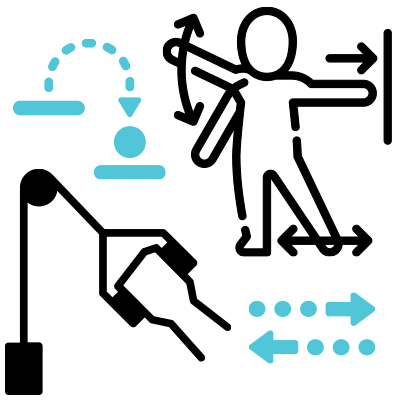 “Where are all the nurses?”
“Where are all the nurses?”
That was the question that Mary Ousley whispered to her sister Dana Case, a fellow nurse, soon after they joined the International Advisory Board of the Center for Innovative Medicine. The two had looked around the table at the other board members and seen only physicians.
“I am in awe of the work that CIM does and of the impressive group of individuals who pursue its mission — but isn’t health care about teamwork?” asks Ousley, whose distinguished career as a national champion of health care quality for senior living and long-term care patients has earned her many accolades.
Once their observation was brought to CIM Director David Hellmann, Ousley says, he quickly began bringing nurses into CIM’s fold, by tapping into the insights and expertise of a variety of nursing experts at different points and for different projects. Now, the nursing profession has achieved a new level of visibility and far-reaching impact at CIM with the establishment of the first nurse CIM Scholar. The scholarship’s funder? None other than Ousley.
“Humanizing medicine is nursing. The holistic perspective we bring as nurses is about humanizing the patient experience, about including the patient’s entire family, about sitting with emotion.” – Abshire Saylor
Martha Abshire Saylor, an assistant professor at the Johns Hopkins University School of Nursing, has been selected to receive the CIM Scholar support. Abshire Saylor, who has clinical experience in cardiac and critical care, has done research aimed at helping patients better manage heart failure. Her most recent research project, “HERoIC,” focuses on the caregivers of patients with heart failure. Her goal: to determine whether providing holistic support for caregivers can improve the quality of life for both patients and those who care for them.
It is that focus on valuing the individual, and on improving the individual’s experience of health care, that drew Ousley to support Abshire Saylor and her work. “Martha’s approach ties in so well to CIM’s mission to humanize medicine,” Ousley says. “So much of humanizing medicine is just listening. And nowhere is this needed more than with older individuals, who so many times are just written off because of their age.
“From what I have learned in my career, if we value the individual and everything about the individual through to their very last breath, then that is some of the most noble work we can do.”
Abshire Saylor says she is deeply grateful for Ousley’s support and honored to be the first nurse CIM Scholar.
“Nurses make up the largest proportion of licensed providers in our health care system,” Abshire Saylor notes. “Enacting innovation in health care will only happen if nurses are engaged and in leadership positions — from conception to implementation. We need to work as a team from the very beginning. That’s a root belief for me,” she says.
As nurse leader, Abshire Saylor says she is particularly well-positioned to advance the efforts of CIM’s new Initiative for Humanizing Medicine (IHM). “Humanizing medicine is nursing,” she says. “The holistic perspective we bring as nurses is about humanizing the patient experience, about including the patient’s entire family, about sitting with emotion.”
Abshire Saylor will meet with nurses and nursing leaders across Johns Hopkins to raise awareness around the Initiative for Humanizing Medicine and to encourage nurses to apply for grant funding from the IHM to pursue patient- or family-focused projects.
“The CIM Scholar funding will also benefit my own research,” says Abshire Saylor. “It gives me thinking and working space that will really advance my work involving caregivers.”
As hospital length of stay has grown shorter, driven largely by financial pressures from insurers, “we are depending on families more and more to help transition patients out of the hospital and back home” — work that involves navigating medication changes, making meals, helping loved ones shower and dress, and transporting them to appointments, she says. With chronic diseases like heart failure and dementia, caregiving really has no end point.
“Until now, most of the emphasis with caregivers has involved teaching them to provide care to the patient,” says Abshire Saylor. “What’s been missing, and what projects like HERoIC are addressing, is a focus on providing support for caregivers themselves.”
Ousley says she is thrilled to see nursing gain a prominent new seat at the CIM table and that Abshire Saylor is the ideal candidate to forge partnerships with physicians and others on the health care team to improve the patient experience.
“I have been excited about everything CIM has done during years I have served on the board,” says Ousley. “But nothing has excited me more than the Initiative for Humanizing Medicine.”
Don Willett October 31st, 2023
Posted In:

For years, the gymnasium in the Mason F. Lord Building on the Johns Hopkins Bayview Medical Center campus served as a popular spot for faculty members, staff and trainees to stay active — shooting some hoops or taking a fitness class.
Soon, the 10,000-square-foot space will have a new but related mission: It will serve as a hub for collaborative research aimed at keeping older adults active and living independently at home for as long as possible.
The new center, part of the Johns Hopkins Human Aging Project (HAP), marks the first time that engineering students and faculty members from Johns Hopkins’ Homewood campus will have a dedicated research home for collaboration with clinicians and researchers at Johns Hopkins Bayview, a campus with a rich array of geriatrics-related clinics, centers and labs.
“The new space offers an exciting opportunity for our engineers to work together with clinicians, nurses, older adults and their caregivers to come up with technology-driven solutions to some of the biggest challenges older people face, such as social isolation or mobility issues,” says Najim Dehak, an associate professor of electrical and computer engineering and the 2021 Whiting School of Engineering/HAP Scholar. “We aim to leverage technology to extend the time that older adults can remain living safely and independently at home.”
“The new space offers an exciting opportunity for our engineers to work together with clinicians, nurses, older adults and their caregivers to come up with technology-driven solutions to some of the biggest challenges older people face, such as social isolation or mobility issues.” – Najim Dehak
With its plentiful conference rooms, labs and offices, the space will provide a new home for engineers affiliated with the Johns Hopkins Artificial Intelligence & Technology Collaboratory for Aging Research (AITC) — which was established in November 2021 with $20 million in funding from the National Institute on Aging — and for multidisciplinary teams working within the Gerotech Incubator Program.
The Gerotech teams bring together engineering students with nursing doctoral students, medical residents, business students and faculty mentors to tackle an aging challenge, develop a prototype solution and — in some cases — move the product through to commercialization.
“One important element of the new space is a model apartment that will have many of the features of home,” says Dehak. “It will be here that we can bring older adults and their caregivers to conduct clinical tests of devices that have been developed through the AITC and by Gerotech teams.” Technological solutions for healthier aging will run the gamut, Dehak says, from robotic social companions to sensors that promote deeper sleep for better brain health.
“It will be wonderful to have space for older adults to try out and test wearable devices and sensors that are being developed to monitor their health,” says Dehak, who is a leader of the technology core of the Johns Hopkins University Claude D. Pepper Older Americans Independence Center at Johns Hopkins Bayview, which was launched in 2003 and recently received a five-year renewal of federal funding.
“Our vision for the CIM-supported Human Aging Project is a future where aging is not a barrier to living a fulfilling and independent life,” says HAP Director Jeremy Walston, the Salisbury Family Foundation CIM/HAP Scholar. “By forging important new collaborations with engineers, we can tap into technology to develop the tools and resources older people need to age in place safely and comfortably. This new space will provide a critical hub to make that happen.”
The Human Aging Project has already attracted more than $60 million in funding, and 11 faculty members are now supported in their work as HAP scholars. Nine of those HAP scholars have been funded through CIM, Walston notes.
“Our goal is not only to help older adults live longer, healthier and independent lives but also to extend the reach of our discoveries to everyone,” notes Ed Schlesinger, dean of the Whiting School of Engineering.
“The advances our students and faculty are making in artificial intelligence and sensor technology are enabling ‘smart,’ connected homes, and the user-friendly interfaces they’re developing for human language technology make it easier for older adults to benefit from these advances,” Schlesinger says.
“We are excited to see our engineers find a new home at Johns Hopkins Bayview and to further extend our partnership with Johns Hopkins Medicine — and I am confident that their collaboration with clinicians, patients and caregivers will result in practical new solutions that will improve the quality of life for older adults the world over.”
Don Willett October 31st, 2023
Posted In:

If you’re like most fans of the Center for Innovative Medicine, you’ve got a recurring event on your calendar you aim not to miss: the CIM Seminars, which unfold on Tuesday afternoons at 4 p.m. via Zoom. Each session features a keynote speaker invited by CIM Director David Hellmann to share highlights of his or her current work on fascinating topics ranging from humanities in medicine to artificial intelligence and early detection of cancer.
This academic year, Hellmann invited the newest CIM Scholar, Johns Hopkins cardiologist Thomas Traill, to act as a co-planner for the CIM Seminars. A professor of medicine, Traill is former associate director of the Osler Medical Housestaff Training Program for residents.
“Tom is a brilliant and thoughtful cardiologist with deep interest and knowledge of the history of medicine,” says Hellmann. “I’m thrilled that he will be planning and hosting about half of the year’s seminars, focusing on the important theme of healing.”
In the Q&A that follows, Traill talks about his vision for the CIM Seminars and, more broadly, why it’s so important in today’s health care milieu not to lose sight of the human side of medicine.
Could you share a bit about your thematic vision for the seminars you planned — and how that ties into CIM’s ongoing mission to humanize medicine?
Like CIM, I wholeheartedly subscribe to the importance of keeping medicine humanized. I also believe there are pressures that increasingly threaten that intent.
In this early 21st century, we are living in the era of molecular medicine. We read every day about the discovery of a new disease-causing molecule and the therapeutic molecule that’s going to fix it. Molecular medicine allows for extraordinary precision, stuff that would have been unbelievable even a few years ago.
“Like CIM, I wholeheartedly subscribe to the importance of keeping medicine humanized. I also believe there are pressures that increasingly threaten that intent.” – Thomas Traill
But as physicians, it’s forced us to move to a different level of looking at human beings, a different scale. We are looking at molecules, not organs. We are looking at molecular physiology and no longer at how the body works as a whole, how whole organs fail. This is a huge shift in the ground for all disciplines of medicine. And I believe it comes at a cost to understanding and explaining to our patients, to our ability to heal people, and to medical education.
Along those lines, the first of the talks I organized was given in September by Johns Hopkins psychologist Kay Redfield Jamison, who also happens to be my wife. She focused on the “wounded healer,” which is a theme of her newest book, Fires in the Dark: Healing the Unquiet Mind. Her book explores how psychotherapy and medicine, as well as rituals, nature, religion, love and music, can all be crucial to healing. One healer Kay focuses on is Sir William Osler, who lost his beloved son, Revere, in World War I. The elder Osler’s own grief and suffering shaped his ability to bring healing to others.
You’ll also be bringing in the voices of some speakers from outside of medicine?
Yes, I’ve invited two people to speak in December who are episcopal priests. Stuart Kenworthy and David Peters have served on the front lines as Army chaplains in Iraq. They have extraordinary stories to tell about caring for people who have experienced physical trauma and moral injury: both injured soldiers and also themselves.
On a slightly more light-hearted note, you also gave a talk that looks at how doctors are perceived by the public based on how they are portrayed in fiction and on the screen.
If you watch just a few minutes of an episode of the iconic TV series Marcus Welby, M.D., which starred Robert Young and aired from 1969 to 1976, you’ll find him talking about what gets him up in the morning and his affection for being a “real doctor.”
Around the same time, there was Dr. Finlay’s Casebook, the BBC series that ran from 1962 to 1971, based on the books of A.J. Cronin. Dr. Finlay was a stalwart of general practice. He comes home from World War II as a young, psychologically wounded practitioner and then devotes himself to serving patients through the newly established National Health Service.
Then, put them both up against actor Hugh Laurie, the titular star of the TV show House [which ran on Fox from 2004 to 2012]. House is a very interesting character. In the very first episode, he comes up with remarks like, “Everybody lies,” and “Humanity is overrated.” Then he pulls a diagnosis out of the air without ever seeing the patient. Other times, there are allusions to Sherlock Holmes, who would astonish people by recognizing who they were and where they’d been before they had even opened their mouths — another complicated man.
The evolution from Marcus Welby and John Finlay through to the brilliant misanthropic House sheds an interesting light on how the public sees us and how young people see the profession that they are about to enter. In interviews I’ve done with residency applicants, several have said they were impressed with House and wanted to be like House, at least in his positive aspects.
You have other speakers?
Yes. Karen Swartz in psychiatry and Duke Cameron in cardiac surgery, both people I have known for much of my career at Johns Hopkins and whom I admire enormously for their care of patients. Karen will be speaking about the intersection between psychiatry and public health in recognizing depression in school-age children. Duke will speak to the complex relationships we have with medical technology — the good and the not so good.
That offers a nice segue into your thoughts about the state of bedside teaching of physician trainees.
Going all the way back to William Osler, he felt passionately that people who teach medicine should be the people who are doing medicine. What was true then is even more true now. I worry that bedside teaching by the great clinicians — the Philip Tumultys of the world — is really threatened, as precision medicine and expert guidelines start to dominate hospital practice and as diagnostic workups are increasingly taking place in the Emergency Department. The days of someone like Osler sitting at a patient’s bedside in the wards and scratching their chin over a diagnosis are mostly gone.
“The Johns Hopkins of the future should be a place where young doctors in training can see today’s generation of Oslers scratching their chins — but this will probably need to take place in the outpatient clinic, not by the bedside in the hospital.” – Thomas Traill
The Johns Hopkins of the future should be a place where young doctors in training can see today’s generation of Oslers scratching their chins — but this will probably need to take place in the outpatient clinic, not by the bedside in the hospital. It’s in the outpatient clinics where most of today’s patients are coming in undiagnosed and in need of human help.
Don Willett October 31st, 2023
Posted In:
This fall, the Miller Coulson Academy of Clinical Excellence (MCACE) at Johns Hopkins inducted 12 new clinicians — doctors who are the “best of the best” when it comes to providing patient care.
The new class of academy members joins nearly 100 clinician members, from departments across Johns Hopkins, who are all committed to establishing initiatives and programs to advance excellence in clinical care.
The 2023 Miller Coulson Academy inductees are:
Chetan Bettegowda, M.D., Ph.D.
Departments of Neurosurgery, Oncology, and Radiation Oncology and Molecular Radiation Sciences
Youngjee Choi, M.D.
Departments of Oncology and Medicine, Division of General Internal Medicine
Nicholas Dalesio, M.D., M.P.H.
Departments of Anesthesiology and Critical Care Medicine, Otolaryngology – Head and Neck Surgery
Julia Deanehan, M.D.
Department of Pediatrics — Emergency Medicine
Ana Maria Cristina DeJesus-Acosta, M.D.
Department of Oncology, Gastrointestinal Cancer
Marco Grados, M.D., M.P.H.
Department of Psychiatry and Behavioral Sciences, Child and Adolescent Psychiatry
Rani Hasan, M.D.
Department of Medicine, Division of Cardiology
Jennifer Katzenstein, Ph.D.
Department of Psychiatry and Behavioral Sciences, Child and Adolescent Psychiatry
Mary L. O’Connor Leppert, M.B.B.Ch.
Department of Pediatrics, Kennedy Krieger Institute
Scott Lifchez, M.D.
Departments of Plastic and Reconstructive Surgery, Orthopaedic Surgery
Jose Monroy-Trujillo, M.D.
Department of Medicine, Division of Nephrology
Mustapha Saheed, M.D.
Department of Emergency Medicine
Don Willett October 31st, 2023
Posted In:

When CIM Director David Hellmann describes the research mission of Johns Hopkins rheumatologist Max Konig, he uses an analogy drawn from the movies — Clint Eastwood’s Dirty Harry character, who sets out to clean up a corrupt San Francisco police department by taking out the handful of “bad cops” who are ruining the entire system.
“Our immune system is like the police system of our body, and when we encounter autoimmune diseases, it’s due to a few ‘bad cops’ attacking the normal citizens in our body,” says Hellmann. “Just as Clint Eastwood selectively goes after each of the bad cops, leaving the good cops in place to protect us, so Dr. Max Konig is working to develop precision therapies that will leave the ‘good cops’ unharmed, allowing patients to escape the complications that are so common with current therapies for autoimmune disease.”
Konig, an assistant professor who completed his residency training at Harvard and advanced training in rheumatology at Johns Hopkins before joining the faculty, is now at the leading edge of a promising new line of investigation. He is capitalizing on cellular therapy approaches that have become the standard of care in treating cancer to develop precision treatments for devastating autoimmune diseases like lupus, rheumatoid arthritis and antiphospholipid syndrome, which is implicated in heart disease, stroke and pregnancy loss.
“Although we are at the very edge of the journey,” says Konig, “there is a sense of enormous potential to use engineered cell therapies to create tailored solutions to prevent, control and cure autoimmune diseases.”
He is motivated by a sense of urgency, since existing treatments for autoimmune diseases carry potentially toxic side effects that can be debilitating and even deadly. That’s because only a tiny percentage of cells drive autoimmune disease, “but as rheumatologists, we currently have to use an armamentarium of drugs to ‘burn down the whole forest’ to get control of that very small population,” he explains. The impact on patients of this toxicity? A high risk of infection, poor response to vaccines and treatment-related deaths.
“Although we are at the very edge of the journey, there is a sense of enormous potential to use engineered cell therapies to create tailored solutions to prevent, control and cure autoimmune diseases.” – Max Konig
Konig is building on advances in CAR T-cell therapy, a type of immunotherapy that is increasingly being used to treat patients with B cell-driven blood cancers, including lymphoma, leukemia and multiple myeloma. Simply explained, the treatment involves collecting a patient’s “killer” T cells, then reengineering those cells to recognize and attack the cancer by binding to proteins, or antigens, on the cancer cells’ surface. Different types of cancer have different antigens, so each type of CAR T-cell therapy is made to fight a specific kind of cancer antigen.
After being reengineered, the cells are allowed to multiply and then infused back into the patient to do their cancer-fighting work.
“It’s remarkable that this works — that CAR T cells can actually cure blood cancers,” says Konig. “This is no simple feat. In order to cure a cancer, you need to get rid of every single last cell or the cancer will come back.”
The success of CAR T treatment has led Konig and others to wonder: “If we have such a unique and incredibly powerful tool to cure B cell cancers, could it be applied to treat B cell-driven autoimmune diseases?” He and others believe the answer is “yes.”
“We are on the verge of the next step in treating autoimmune diseases, one that will bring us into a new era of cell engineering and cellular therapies,” says Konig, “where all of a sudden we have the tools to design really tailored solutions.”
He points to early clinical trials in Germany in five young adults with moderate to severe lupus who had not responded to existing treatments. After undergoing B cell-targeted CAR T treatment (which eliminates good and bad B cells alike), “all these patients were in complete clinical and immunological disease remission,” he says. Other researchers have taken a similar strategy and produced similarly encouraging remission outcomes in patients with MS spectrum disease and myositis.
In his lab at Johns Hopkins, Konig and his colleagues in the Ludwig Center, part of the Kimmel Cancer Center, are furthering this strategy by developing and using a new generation of T cell therapy approaches — such as CRISPR-based engineering of chimeric autoantigen-T cell receptors — to reprogram a patient’s T cells so they can selectively target self-reactive immune cells while safeguarding normal immune populations.
“These precision therapies have the potential to transform the lives of patients living with autoimmune and rheumatic diseases by providing new tailored treatments that can control autoimmunity without increasing the risk of infection that is common to all existing treatments,” Konig notes.
The “hope message” Konig is eager to share? “I really think engineered cellular therapies will enable a future where we can treat, prevent and cure autoimmune diseases.”
Don Willett October 31st, 2023
Posted In: